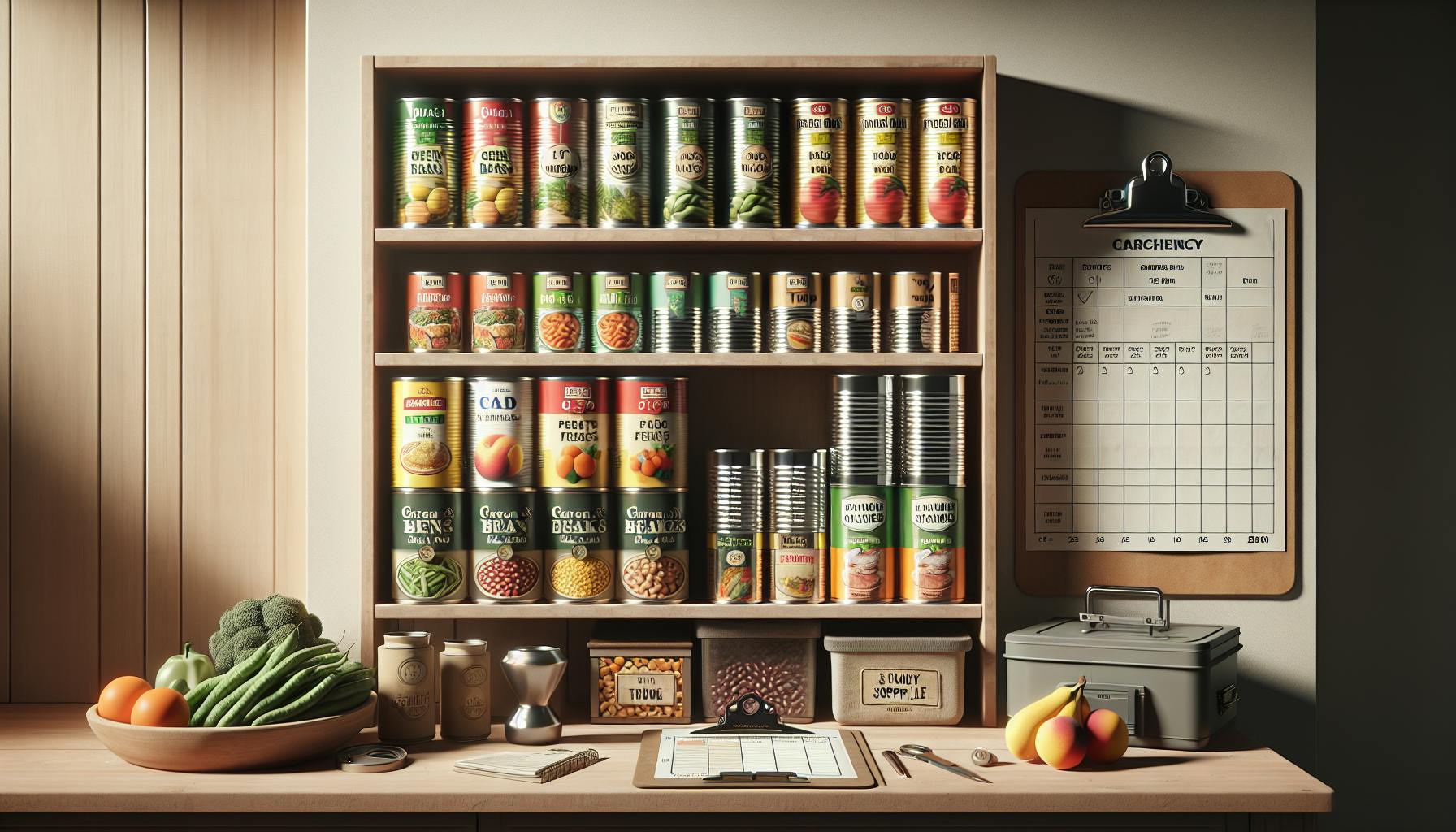When building an emergency food supply, preppers would agree that canned meats with long shelf lives are an important consideration.
The good news is that with the right selection and storage methods, certain canned meats can last 20 years or more.
In this guide, you'll discover the canned meats with the longest documented shelf lives, learn how to decode expiration dates, and get tips to maximize longevity in your prepper pantry.
Introduction to Longest Shelf Life Canned Meat for Preppers
Canned meats can play an integral role in an emergency food supply. When properly stored, they can last for years beyond their expiration date. Understanding how to maximize shelf life is key for preppers building up a stockpile.
This article will cover the basics around using canned meats for emergency preparedness. We'll explore the actual longevity you can expect, dispel some myths about decade-long shelf lives, and provide tips for storing your supply.
The Role of Canned Meats in Emergency Preparedness
Canned meats provide essential protein and nutrients in a shelf-stable format. Key benefits for preppers include:
- Long shelf life - Most canned meats last 2-5 years unopened when properly stored. Some may last even longer past expiration dates if conditions are ideal.
- Nutrient density - Canned meats contain protein, vitamins, minerals and fat necessary for health. They offer more nutritional value than other preserved items.
- Space efficiency - With a smaller footprint than other proteins, canned meats efficiently use precious storage space in a prepper's pantry.
Having canned meats as part of your food stockpile provides insurance against emergencies disrupting normal access to fresh foods.
Understanding Expiration and Shelf Life
There are some common misconceptions about expiration dates. These dates indicate peak quality rather than safety or shelf life.
As long as the can remains intact with no rust, bulging or leaks, canned meat remains safe indefinitely. Over time, color, texture and nutritional value degrade slowly. Most retain good visual quality and nutrients 2+ years after expiration.
Properly stored canned meat can often last 5+ years past its date. One study found canned meat edible up to 9 years later with only slightly diminished quality.
So while canned meat may last for decades, optimal nutritional content and palatability decline after several years. Most preppers consume and replenish stock within 5 years.
Myths and Realities: Can Canned Food Last 20 to 100 Years?
There are apocryphal stories of 100+ year old canned goods being tested and found edible. However, few definitive studies exist proving extremely long shelf lives. Some cans tested from turn-of-the century shipwrecks contained viable food, but most were far from optimal.
Modern manufacturing and can linings likely facilitate longer life spans than older versions. However, flavor, texture and nutrition still degrade over time. For preppers, shelf lives beyond 5-10 years are unrealistic.
Focus instead on proper short and mid-term storage conditions. This includes cool, dark spaces with minimal temperature fluctuations to preserve quality for those crucial first years of shelf life.
Setting Up Your Prepper Pantry for Longevity
To maximize canned meat freshness in your prepper stockpile:
- Store cans in a cool, dark place around 40-70°F if possible. Avoid temperature swings.
- Use oldest stock first and replenish with new supply every 2-5 years. Mark purchase dates with markers.
- Inspect cans periodically for rust or damage which can decrease shelf life.
- Consider adding oxygen absorbers to storage containers to prevent oxidation.
Properly stored canned meats offer exceptional emergency preparedness value for preppers through their long shelf life and nutritional qualities. Just be realistic about longevity past 5 years and take steps to optimize storage conditions. This ensures you get the most out of every can when it matters most.
Can you eat 20 year old canned meat?
Canned meats can remain safe to eat for years past their expiration date, as long as the can itself is in good condition with no rust, dents, or swelling. This is because the canning process kills bacteria and creates an airtight seal that prevents new bacteria from getting in.
However, while canned meat may be technically safe to eat after 20 years, the quality and nutritional value will degrade over time. Some changes you may notice in older canned meat include:
- Texture changes - the meat may become mushier or take on a stringy consistency
- Flavor changes - the taste may become more metallic and acidic
- Nutrient loss - vitamins like C and B deplete over time while canned meat is stored
- Potentially tougher chew - connective tissues can solidify during prolonged storage
So if faced with a 20-year-old can of meat, safety shouldn't be a concern if the can appears normal. But the eating experience likely won't be great. For best quality and nutrition, canned meats are ideally consumed within 1-5 years. The longer shelf life allows preppers to stock up, but frequent rotation of supplies is still recommended.
Prioritizing canned meats with the longest shelf lives can provide more flexibility. For example, cured meats like spam, vienna sausages, or corned beef often last 2-5 years or more. Choosing reliable brands with proven longevity is also important when building your prepper pantry.
What canned meats are good for long term storage?
When stocking your prepper pantry with canned meats for long term storage, there are a few key options that provide an optimal balance of shelf life and nutritional value:
Canned Beef
Canned corned beef and canned beef stew are very shelf-stable and can last 5-10 years when properly stored. Opt for low sodium varieties. Beef is packed with protein, iron, zinc and B vitamins.
Canned Chicken
Canned chicken breast, tuna, salmon, and other seafood have shelf lives around 2-5 years. Chicken provides lean protein, vitamin B, selenium. Choose water-packed tuna and salmon for less sodium.
Canned Ham/Spam
Has a shelf life of 2-5 years due to preservatives like sodium nitrite. Provides protein, but also a lot of sodium, so moderate intake.
When building your prepper pantry, focus on nutrient-dense canned meats like beef, chicken, and fish that deliver protein your body needs. Moderating salty meats like spam. Routinely check cans for swelling, rust, or dents and discard anything questionable. Track storage dates and follow FIFO.
What is the longest lasting canned food?
When it comes to canned foods, shelf life varies significantly depending on the type of food and how it was processed. According to the USDA, high-acid canned foods like fruits and tomatoes will generally keep their best quality for 12-18 months. However, low-acid canned foods like meats and vegetables can keep for 2-5 years if properly stored.
Overall, canned meats tend to have some of the longest shelf lives among canned goods. In particular, commercially packaged canned meat designed for long term storage is optimized for maximum freshness over time.
Some examples of canned meats with exceptionally long shelf lives include:
- Canned ham or spam: 2-5 years or more
- Canned chicken: 5-7 years
- Canned beef or pork: 7-10 years
- Canned fish like salmon or tuna: 3-5 years
The exact shelf life depends on factors like ingredients, canning method, and storage conditions. But with proper rotation and storage, quality canned meats can easily last 5+ years. This makes them a staple for many preppers' pantries when building an emergency food supply.
When combined with other canned goods like fruits, vegetables, and beans, a well-stocked prepper pantry can provide nutritious and tasty meals for years to come, even in extended emergencies. So focusing on longest shelf life canned foods with the best nutritional content is key for maximum preparedness.
sbb-itb-b932644
How long can canned meats last?
Canned meats can have a surprisingly long shelf life if stored properly. According to the USDA, commercially canned meats like spam, vienna sausages, or canned chicken can last 2-5 years past the expiration date printed on the can.
However, the shelf life depends on several factors:
- Type of meat: Spam and commercially processed meats last longer than home canned meats or raw packed meats.
- Can integrity: Dents, rust, or swelling can compromise the can and shorten shelf life.
- Storage conditions: Cool, dark places like a basement or root cellar preserve canned meats best. Constant temperature fluctuations can shorten shelf life.
The longest lasting canned meats for preppers are commercially packed spam, vienna sausages, canned chicken, and beef stew. With ideal storage conditions, these can last 5+ years past the expiration date on the can.
Home canned meats or raw packed canned meats have shorter shelf lives around 2-3 years when properly processed and stored. Canned tuna and salmon also fall into the 2-3 year range.
No matter what type of canned meat you store, be sure to inspect cans before opening to ensure safety and quality. With the right storage methods, canned meat can be an invaluable source of protein in an emergency.
Assessing Canned Meat Products for the Long Haul
When stocking up on canned meats for emergency preparedness, it's important to understand how shelf life factors in. Let's explore what contributes to canned meat longevity.
Decoding the Home Canning Shelf Life Chart
Home canning methods allow you to preserve meats, but they come with shorter shelf lives than commercial canning. A general guide is:
- Canned ground meats: 1 year
- Canned meat chunks/stews: 1-2 years
Proper sterilization and sealing are key to maximize shelf life. When in doubt, refer to USDA guidelines.
Commercial Canned Meats vs. Home Canning
Commercially canned meats are processed using pressure canners that kill more bacteria. This allows for longer shelf lives of:
- Canned chicken/turkey: 2-5 years
- Canned ham/beef: 2-10 years
Home canning can save money but won't last as long. Commercial cans offer more reliable long-term storage.
Nutritional Content Preservation Over Time
Over years of storage, canned meat loses some vitamins but retains significant protein and fat. As long as the can remains intact and shelf life isn't drastically exceeded, nutritional value remains mostly preserved.
The Best Emergency Food: Canned Meats that Last
For stocking your prepper pantry, opt for commercially canned hams and beef for 5-10 year shelf life. Tuna and chicken also store for 2-5 years. Pair with vegetables and broth for nutritious survival meals.
Prioritize meats with longer shelf lives. Inspect cans and consume within recommended time frames. Properly stored canned meats can provide sustenance in emergencies.
Maximizing Shelf Life and Safety in Canned Meats
When storing canned meats for emergency preparedness, following best practices to maximize shelf life and safety is key. This section offers practical tips for storage, signs of spoilage to look out for, evaluating home canned foods, and assessing canned meats beyond their expiration dates.
Optimal Canned Food Storage Practices
To maximize shelf life of canned meats:
- Store in a cool, dark place between 50°F and 70°F. Temperature fluctuations can compromise can integrity over time.
- Avoid direct sunlight exposure or proximity to heat sources like hot pipes or appliances which can accelerate deterioration.
- Store cans off concrete floors on shelves or pallets to prevent temperature conduction and moisture damage.
- Regularly check cans for signs of rust, dents, swelling, or leaks which can allow bacteria inside, shortening shelf life.
Following these guidelines, commercially canned meats can often last 2-5 years or more before quality loss.
Signs of Compromise in Canned Meats
Watch for these signs of spoilage in canned meats:
- Bulging or leaking cans caused by gas production from bacterial growth. Do not consume these.
- Corrosion, rust, or dents along seams or edges from long-term moisture damage.
- Cloudy broth, unnatural colors, unpleasant odors, or mushy texture indicating microbial growth.
Any of these suggest compromised integrity and unsafe canned meats unfit for consumption.
Evaluating Home Canned Meat Shelf Life
With proper sanitation and processing, home canned meats can potentially last 1-2 years. However, safety requires diligent monitoring:
- Inspect seals for pops or cracks allowing air entry which shortens shelf life.
- Check for cloudiness, odor changes, mold growth, or sliminess signalling spoilage.
- Ensure proper pH and prevent botulism risk by using trusted recipes and procedures.
- Label storage containers with dates and contents for easy tracking.
Consult published guidelines on home canning techniques to maximize quality and safety.
Beyond the Expiration Date: Consuming Outdated Canned Meats
While not recommended generally, if canned meats are free of swelling, leakage, corrosion, or other warning signs, they may remain safe for consumption beyond printed expiration dates, especially if unopened.
To evaluate:
- Inspect condition and seals thoroughly before opening. Never consume from bulging, leaking, or heavily damaged cans.
- Upon opening, check appearance, smell, and texture for changes. Rancid, foul odors or unnatural colors indicate spoilage.
- Small taste tests can check for noticeable changes in flavor, sourness, or bitterness signalling lower quality.
With no clear signs of spoilage, canned meats may retain safety and nutritional value well beyond labeled dates, though quality loss remains a possibility. Proceed cautiously.
Following these tips can help maximize shelf life, safety, and quality when including canned meats in emergency food storage.
Building a Resilient Survival Prepping Strategy with Canned Meats
Canned meats can play an integral role in a comprehensive survival strategy. When selected strategically and stored properly, they provide long-lasting nutrition to sustain you through emergencies.
Strategic Selection of Canned Meats for Prepping
When building your prepper pantry, prioritize canned meats with longer shelf lives first, at least 5 years or more. Top choices include canned ham, spam, chicken, salmon, sardines, and tuna. Compare nutrition labels - look for options packed in water with lower sodium. Avoid canned meats with shorter expiration dates.
Space permitting, diversify with a mix of proteins, including beef, pork, poultry, and seafood. Canned fruits and vegetables also provide essential vitamins and minerals. Make sure to calculate daily caloric needs per person. Stock up gradually over time.
Food for Emergencies: Incorporating Canned Meats
Integrate your supply of canned meats into a larger food stockpile for disasters. Having 3-6 months of supplies is recommended. Store canned goods in a cool, dark place. Consider an emergency food bucket or survival cache to protect them.
When an event occurs, rely first on perishables like fresh produce before breaking into preserved items. Save canned meats for protein when other options dwindle. Portion for multiple days to avoid waste.
The Importance of Diversity in Your Survival Food Supply
Eating the same canned meats daily lacks variety and risks nutritional deficiency. Combine assorted proteins along with fruits, vegetables, grains, nuts, and legumes for a balanced diet.
If relying solely on canned goods for an extended period, focus on nutrient density. For example, sardines and salmon with bones provide beneficial calcium. Mix in vitamin supplements as needed.
Maintaining a Rotation System in Your Prepper Pantry
Use a FIFO (First In, First Out) system to cycle canned meats. Label each new item with purchase date. Move older stock to the front, integrating new inventory behind.
Check expiration or Best By dates every 6-12 months. Consume soon-to-expire cans first. Discard any swollen, leaking, or severely dented cans.
Following these tips will ensure you have safe, nutritious canned meats stocked and ready for whatever comes your way. They are an integral component of a resilient prepping strategy.
Conclusion: Ensuring Preparedness with Canned Meats
Recap of Key Considerations for Longest Shelf Life Canned Meats
When selecting canned meats for your emergency food supply, focus on those with the longest shelf lives to ensure preparedness. Key factors to consider include:
- Meat type - Certain meats like beef and chicken have naturally longer shelf lives than pork or seafood when canned properly. Prioritize these.
- Can integrity - Dents, rust, or swelling can compromise shelf life. Inspect cans closely before purchase and storage.
- Storage conditions - Store cans in a cool, dark place to maximize shelf life. Consider temperature-controlled storage for long-term preparedness.
- Rotation - First in, first out inventory management ensures canned goods get used before expiration.
- Quality checks - Periodically inspect cans for external damage and do "test opens" to check food quality over time.
Final Tips for Preppers on Canned Meat Selection
When building your prepper pantry, focus on versatile, nutrient-dense canned meats with proven long shelf lives. Useful tips:
- Seek out lesser-used cuts like heart and tongue for budget savings.
- Favor canned chicken, salmon, beef, and spam for shelf life over pork or shellfish.
- Buy multiple smaller cans rather than #10 cans to enable easier storage rotation.
- Research and stick to brands with reputations for can integrity over decades.
The Role of Canned Meats in Comprehensive Emergency Preparedness
While canned meats can provide critical protein in an emergency, true preparedness requires a diversified, well-rounded food supply. Include other canned goods, freeze-dried foods, and home-canned items as well to meet nutritional needs in a crisis. Most importantly, continually learn and practice key self-reliance skills like hunting, foraging, gardening, and home food preservation. Combining modern canned goods with traditional methods for supplying food gives preppers the best chance for thriving long-term.


